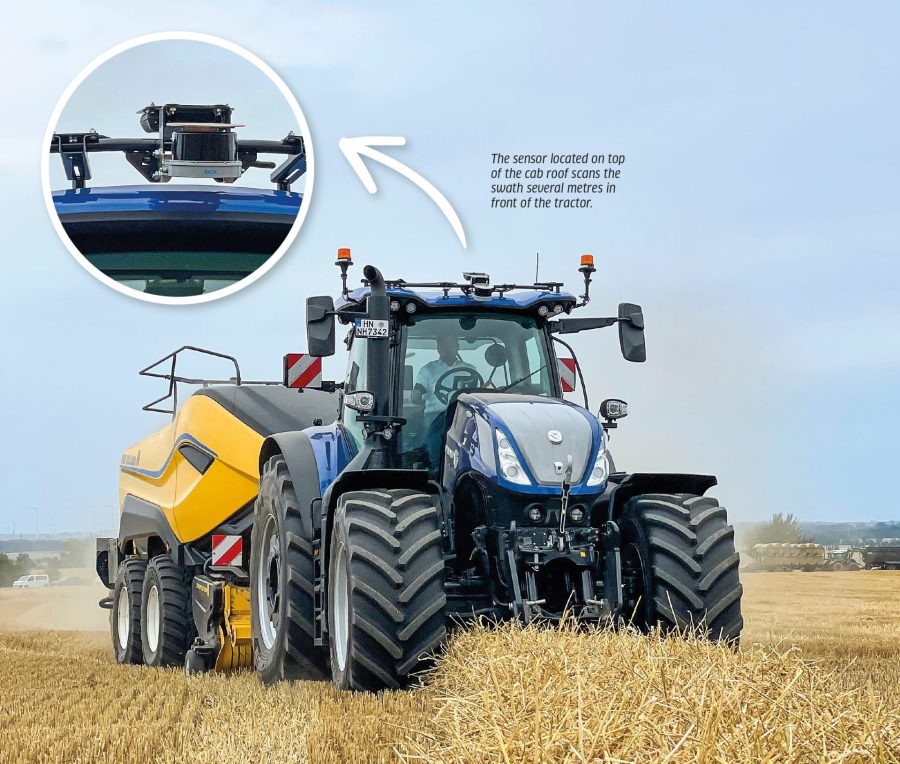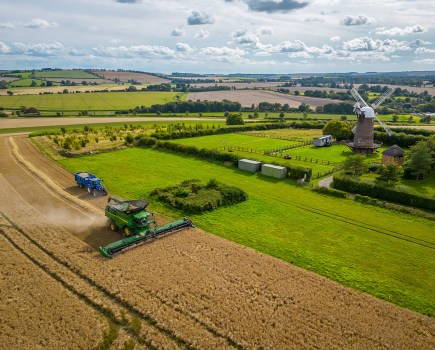IntelliSense utilises a LiDAR sensor to control both the steering and ground speed of the tractor when big square baling. We were able to have a brief drive last summer to learn more.
KEEPING IT BRIEF
- A LiDAR system recognises the swath and measures its volume.
- Based on this information, the baler’s steering system and forward speed are controlled automatically.
- The technology currently demands a T7 or T8 tractor with ISObus Class 3. From 2026 IntelliSense-compatible balers can be used with any make of tractor that has TIM.
When faced with nice and even swaths, making uniform bales is a doddle for most operators. However, these utopian rows are not the norm. Lodged and uneven crops, or like last year when wet straw had to be moved to help it dry, all have an impact on even flake thickness and in turn bale weight. And this is where New Holland’s IntelliSense automatic control system comes into play.
The heart of the system is a LiDAR (Light Detection and Ranging) sensor which is located on the front of the tractor cab roof. In simple terms, this sensor emits laser light beams that are reflected several metres in front of the tractor. Based on the different travel times of the light pulses, the system then calculates the position and volume of the swath.

SmartSteer and…
The driver can utilise this information for proactive automation: firstly for SmartSteer, which automatically steers the tractor along the swath and also takes into account info from the plunger load sensors on the left and right of the bale chamber to ensure it is evenly filled. Depending on conditions, the operator can also preselect three levels of responsiveness for the steering reaction.
We asked the combine operator to put some nice wiggles in the straw row to see how the system would cope with weaving side to side. With SmartSteer activated, the tractor and baler combination had no real problem following the swath at around 10km/hr. It just got on with the job.
According to New Holland, this set-up should work just as well at night and/or in dusty conditions. This wasn’t something we were able to put to the test.

…IntelliCruise
The second step in automation is IntelliCruise, which automatically controls the forward speed. With this activated on the terminal and the desired number of flakes per bale defined, the tractor travel speed is adjusted relative to the cross-section of the swath measured by the LiDAR: firstly to avoid any overloading or major bung-ups with lumps of straw; and secondly to achieve the most uniform flake thickness (and therefore bale density) in the bale despite variations in the swath size.
We were able to test this out with a heap of straw — the tractor reduced its speed and then accelerated again once the lump was ingested by the baler. We weren’t able to simulate varying swath thicknesses, but New Holland’s own tests do show that the flake thickness is much more uniform when IntelliCruise is enabled compared to without the system in operation.
Retrofittable
No doubt, a motivated operator is able to produce uniform bales without this level of automation. However, during long harvest days, the system ensures even inexperienced operators can produce consistent bales, utilise the baler’s capacity and achieve good fuel economy. And even good drivers will quickly appreciate the support.
Regarding the cost of the system, New Holland is not yet committing itself here, but the final price is expected to be around the £7,500 mark. The technology can currently be operated with the manufacturer’s long wheelbase T7 tractors as well as stepless T8 models with Class 3 ISObus and appropriate licences.
From 2026, all tractor models with Tractor Implement Management (TIM) will be able to run the system. On the baler side of things the system can be retrofitted to BigBaler Plus models produced from the end of 2023 and the HD models from 2020.
Hubert Wilmer
For more up-to-date farming news click here and subscribe now to profi and save.





